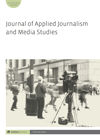
Full text loading...


In 2019, 51 people were killed in terror attacks at two mosques in Christchurch, a city on the east coast of the South Island of New Zealand with a population of around 400,000 people. It was the deadliest mass shooting in the country’s history and the first terror attack of its kind on home soil, attracting extensive international media attention. Given the city’s relative isolation, early coverage was by local media and included local journalism students who had responded to a developing event. This study explores the first-hand experiences of these undergraduate broadcast journalism students who, just a few weeks into a new academic year, covered the news story for national and international media. Using mini focus groups, this descriptive study sheds light on how students with little to no trauma training coped with reporting on such an extreme and unprecedented event and the crucial role soft skills played in guiding their actions.

Article metrics loading...

Full text loading...
References

Publication Date:
https://doi.org/10.1386/ajms_00110_1 Published content will be available immediately after check-out or when it is released in case of a pre-order. Please make sure to be logged in to see all available purchase options.